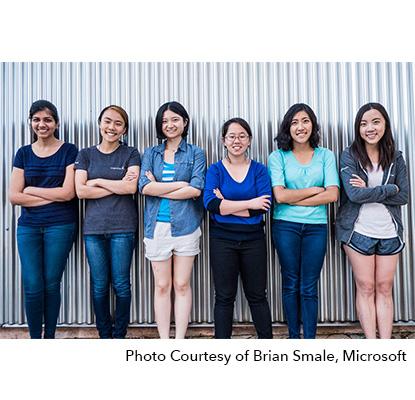Chen Wang, Chandani Doshi, Grace Li, Jessica Shi, Charlene Xia, Tania Yu
Six mechanical, materials science, computer science and electrical engineers—all women, all seniors at the Massachusetts Institute of Technology (MIT) joined forces to “improve the world, one innovative solution at a time.” The team is developing Tactile, a portable device that translates printed text into braille, the raised-dot system that allows blind people to read via touch.
Chen (Bonnie) Wang, from Albuquerque, New Mexico, a materials science and engineering student, has been an undergraduate research assistant in MIT Professor C. Cem Tasan’s metallurgy laboratory, held internships or externships with the Shell Technology Center in Bangalore, India, the BMW Group in Munich, Germany, and Johnson & Johnson in Somerville, N.J. She’s also served as events director for the MIT Consulting Group, among other activities. She has conducted market-sizing research and explored community partnerships for Tactile.
Chandani Doshi, from Gurgaon, Haryana, India, an electrical engineering and computer science student, has held internships at InterGlobe Technologies and AUTOnCAB/NGA Technologies, both in Gurgaon, India, as well as at IBM research in Cambridge. She also volunteered for an organization that develops web-based learning software for visually impaired children, testing the application at a local school for the blind. She is drawing on her software engineering background to develop Tactile’s printed text scanning system.
Grace Li, from Monmouth Junction, New Jersey, a mechanical engineering student, has held internships at NASA Jet Propulsion Laboratory in Pasadena, Calif., and IBM in Cambridge, Mass. She’s been an undergraduate researcher in the MIT Media Lab’s Fluid Interfaces Group and a lab assistant in the Department of Mechanical Engineering. She’s also the founder and president of MIT STEAM, an initiative encouraging greater collaboration between the STEM fields (science, technology, engineering, and mathematics) and the arts. For Tactile, she working on the design of the braille output mechanism.
Jessica (Jialin) Shi, from Durham, New Hampshire, also a mechanical engineering student, has been an intern at Saint-Gobain in Northborough, Mass., the Colder Products Co. of Minneapolis, Minn., and MIT’s Kolpack Group, which emphasizes computation materials design for sustainable energy. She’s also been an undergraduate researcher at MIT’s Laboratory for Bio-Inspired Interfaces as well as a Microsoft Student Partner, teaching workshops and leading demonstrations on emerging technologies for her peers. She serves as systems integrator for Tactile, working closely with teammates on the device’s refreshable display and its image-processing capabilities.
Charlene Xia, from Orange Park, Florida, another mechanical engineering student, has been an intern at Saint-Gobain in Northborough, Mass., and an undergraduate researcher at both MIT’s Tata Center for Technology and Design and the Tsinghua University Ceramic Material Lab in Beijing, China. She and Jialin were co-presidents of the MIT China Care Club, which raises money for Chinese orphans and provides activities for local Chinese adoptees and their families. She’s drawing on both her major field and her minor in materials science and engineering to develop Tactile’s refreshable braille display.
Tania Yu, from Randolph, New Jersey, an electrical engineering and computer science student, has been an intern at Google in Mountain View, Calif., and undergraduate researcher at both MIT’s Computer Science and Artificial Intelligence Laboratory (CSAIL) and the Tsinghua University Institute for Interdisciplinary Information Services in Beijing, China. She also works with Jialin and Charlene for MIT’s China Care Club to help raise money for Chinese orphans and plan cultural lessons and events for adopted Chinese children in Boston. She’s working closely with her teammates on developing the software component of Tactile’s printed text scanning system.
The tight-knit group says it hopes to expand its work to other areas—and encourage more girls
to consider careers in the STEM fields as well. “As inventors, we want to tackle pressing issues, and we want to inspire other young engineers to do the same,” they said.


